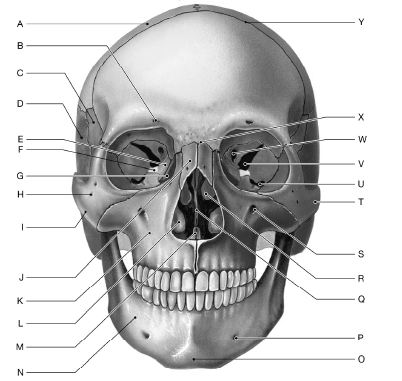Using the figure below, identify the labeled items.

1) Label A: ______________________________
2) Label B: ______________________________
3) Label C: ______________________________
4) Label D: ______________________________
5) Label E: ______________________________
6) Label F: ______________________________
7) Label G: ______________________________
8) Label H: ______________________________
9) Label I: ______________________________
10) Label J: ______________________________
11) Label K: ______________________________
12) Label L: ______________________________
13) Label M: ______________________________
14) Label N: ______________________________
15) Label O: ______________________________
16) Label P: ______________________________
17) Label Q: ______________________________
18) Label R: ______________________________
19) Label S: ______________________________
20) Label T: ______________________________
21) Label U: ______________________________
22) Label V: ______________________________
23) Label W: ______________________________
24) Label X: ______________________________
25) Label Y: ______________________________
1) Parietal bone
2) Supra-orbital foramen
3) Sphenoid
4) Temporal bone
5) Ethmoid
6) Palatine bone
7) Lacrimal bone
8) Zygomaticofacial foramen
9) Zygomatic bone
10) Nasal bone
11) Maxilla
12) Inferior nasal concha
13) Vomer
14) Mandible
15) Mental protuberance
16) Mental foramen
17) Perpendicular plate of ethmoid
18) Middle nasal concha
19) Infra-orbital foramen
20) Temporal process of zygomatic bone
21) Inferior orbital fissure
22) Superior orbital fissure
23) Optic canal
24) Frontonasal suture
25) Coronal suture
You might also like to view...
Answer the following statements true (T) or false (F)
1. The prone position is a position in which the body is lying face up. 2. The supine position is a position in which the body is lying face up. 3. Superior means toward the head. 4. Because humans walk upright, superior and superficial mean the same thing. 5. Anterior and proximal are opposite terms.
The type of membrane that lines freely movable joints is a ________ membrane.
A. pleural B. visceral C. synovial D. mucous E. serous
Which of the following athletes are at greatest risk of developing a shoulder injury?
A) tennis players B) basketball players C) runners D) baseball pitchers E) golfers
Hormone A is a large protein composed of several polypeptides. Hormone B is a small fatty acid derivative. Which of the following statement correctly predicts the way these hormones interact with their target cells?
A. Hormone A and hormone B would bind to membrane-bound receptors. B. Hormone A would bind to a membrane-bound receptor, while hormone B would bind to an intracellular receptor. C. Hormone A and hormone B would bind to intracellular receptors. D. Hormone A would bind to an intracellular receptor, while hormone B would bind to a membrane-bound receptor.